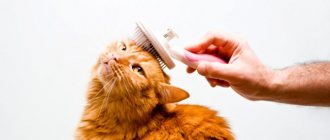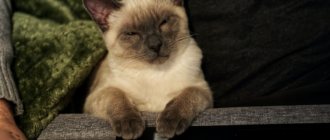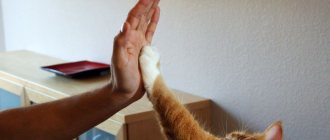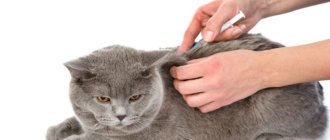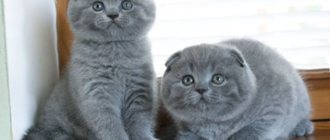Under natural conditions, animals quietly get rid of keratinized particles in the process of moving on hard surfaces, while climbing trees, hunting, etc. At home, pets do not have this opportunity, therefore, if the cat is not accustomed to a scratching post, furniture, etc., are used. walls, carpets.
Do not rush to punish the fluffy - just carry out hygienic trimming of the claws. It is performed using a special tool - a nail clipper. You can find several types of this device in pet stores.
Why do you need to do a cat manicure?
Cats' claws invariably grow, and they need to be tidied up - trimmed using a special nail clipper. Overgrown claws can cause discomfort to the animal or cause injury.
In nature, cats walk on hard surfaces or wear down their claws on trees and other convenient objects. At home, animals are deprived of this opportunity and cannot do without human help. Therefore, from time to time they need the so-called cat “manicure”.
Overgrown claws can become ingrown or cause discomfort when walking. The cat may also get caught in a carpet loop or some piece of furniture, which will lead to a finger injury and medical intervention.
When their claws grow long enough, cats begin to grind them down themselves. In the best case – on a scratching post, in the worst – on wallpaper or furniture. Timely manicure is the key to the cat’s health and the integrity of the owner’s sofa.
The need for nail clippers
Naturally, claws wear down during fairly long walks on concrete or asphalt. However, this is often not enough. Considerable attention should be paid to the claws on the lateral or dewclaws. The dogs don't reach the ground, so they don't wear off. As the dewclaws grow, they sometimes grow into the skin, causing pain if they are allowed to grow excessively. Under any circumstances, attentive dog owners have a tool that can help keep their pet's paws and claws in perfect order. This is a nail clipper.
What is a claw cutter
People use nail scissors to take care of their nails. And for cats there is a special accessory - a nail clipper. It differs from nail scissors both visually and functionally. The appearance of a nail clipper depends on the type, although they are all roughly similar. Only the electric nail grinder is radically different.
Description of the tool
There are four types of cat nail clippers. Each one has its own individual appearance and nuances of working with it.
In a veterinary pharmacy or pet store, you will immediately recognize nail cutters: these are small pruning scissors, the blades of which have a recess for the claw. Well, the grinder looks like a plastic handle with a small rod that rotates at high speed and grinds down the claw.
It is optimal to choose a tool with a handle that is comfortable for you: it fits in size, does not slip, and does not squeeze your fingers. The blades must be serrated, sharp, smooth and shiny.
Why regular manicure accessories are not suitable
A human nail and a cat's claw have different structures and densities, which is why different care products are selected. The nail is a plate that does not itself have nerve endings and blood vessels, so when cutting, only the skin and tissue of the finger can be damaged.
The cat's claw has a hollow structure and a crescent-shaped curve. It contains blood vessels and nerve endings that are very easy to damage, causing pain and bleeding. It is much easier to injure a cat with ordinary scissors than with a nail clipper.
Another caveat: human scissors or wire cutters tear apart a cat’s claw, which leads to problems ranging from crumbling to bleeding or ingrown nails. The nail cutter cuts the plate more evenly and sharply, so the claw does not peel off.
Before you begin the nail trimming process, it is important to familiarize yourself with the basic anatomy of a cat's claw and paw and learn how to correctly determine the length that needs to be left.
Alternative options
If you don’t have the right tool at hand, you can use nail clippers or regular scissors with sharp blades. Before the procedure, instruments must be disinfected with alcohol or chlorhexidine.
I trim my cat's claws with my own tweezers; I didn't buy a nail clipper separately.
Alexander Chichaev
https://www.petshop.ru/forum/?PAGE_NAME=read&FID=30&TID=2346&buf_fid=31&PAGEN_1=2
In the future, it is still recommended to purchase special tools for removing the stratum corneum, since cutting will need to be done regularly and repeatedly.
How not to cut your nails
Nails should not be trimmed with nail scissors intended for human use. A person's nail plate is much thinner than a cat's, so this tool is ineffective here. At best, it will simply break; at worst, it will damage the claw, which will lead to further delamination.
Types of devices
There are variations of nail clippers of different types, models, shapes and designs. There are some that are very easy to use - they are suitable for novice cat owners, and there are special ones designed for professional breeders and groomers.
Before going to the store, it is better to find out what the differences are between the main types of nail clippers, as well as their advantages and disadvantages.
Guillotine
This type of tool consists of two working parts: movable and fixed. Trimming is performed by a moving part, which is installed perpendicular to the claw placed in a special hole. The use of guillotine claw clippers requires certain skills, since when fixing the nail plate it is not visible. However, despite this disadvantage, guillotine-type tools are very popular - especially among owners of large cats with hard claws.
Scissor nail clipper
Scissors are the simplest solution. Outwardly, they resemble human manicures, only with rounded blades and a hole in the middle. It is intended for laying the claw and fixing it during the procedure.
The tool is very easy to use: you place a cat's claw in the notch, the handles close together, and the result is a neat, smooth cut. Suitable for small cats and kittens.
Nail clipper-secateurs
Resembles regular wire cutters or needle nose pliers. The handles have rubber linings, fit comfortably in the hand and do not slip. The spring included in the mechanism also makes working with the accessory easier. The cut is better than that of scissors.
Most models are equipped with a special limiter that sets a certain length and protects against cutting off excess. A special safety lock blocks the cutting surfaces when the pliers are not in use. There are straight and curved models on the pet products market.
Electric nail clipper or grinder
This is a power tool, so it is the most functional and expensive. During operation, the grinder head with an abrasive coating rotates and grinds down the claw plate like a nail file. The device comes with various attachments and limiters.
A beginner without the skill of working with an electric grinder can easily injure a pet by affecting the living part of the claw. Such devices are more often used in professional grooming salons. In stores you can find models that operate on mains power, batteries, and rechargeable batteries.
First aid for injuries
Most dogs are very worried before trimming their nails , even if they have not experienced negative emotions about this before. One option is relaxation medications. As a rule, sedatives are produced from herbs and weaken nervous excitability, all this gives exactly the effect that is required for a cosmetic procedure. Then prepare special powder, powder or wipes with hemostatic properties. If you cut the claw too deeply, several dozen important vessels will be damaged. Quite often, injuries are accompanied by severe bleeding, and this initiates mutual panic for both dog and owner.
It is important to know that under no circumstances should you treat a damaged claw with the following drugs:
iodine;- fucorcin;
- hydrogen peroxide;
- dimexide;
- alcohol;
- brilliant green;
- vodka.
If you don’t have special powder or baby powder nearby, then ordinary food flour will do. All kinds of cauterizing and alcohol-containing solutions will only increase the pain!
Another rather difficult injury is claw tearing . Most often, this happens if you squeeze the nail clippers for a long time, and the dog suddenly jerks its paw. The secured claw remains in the clamp, and the soft tissue and skin are torn.
The first thing to remember is that this is very painful for the dog! Get ready for your tailed friend to whine loudly and try to run away. Operate quickly enough and without panicking:
- Constantly talk to the dog, console him, do everything in order to distract him from what is happening.
- Intercept the wounded paw with a piece of gauze in the area of the wrist (metatarsus).
- Tighten and secure the gauze thoroughly, while it is recommended to raise the limb as high as possible. Apply cold to the injured paw - ice, a piece of minced meat, frozen vegetables taken from the freezer. Wrap the compress in cotton cloth and cellophane in advance. Cold can help stop blood flow and moderate the pain to some extent.
- Carefully examine the wound, and if there are open tissue tears, fill them with novocaine or lidocaine.
How to choose a nail clipper for cats
It’s best to choose a nail clipper for cats this way: whichever tool is convenient for the owner, that’s what you should buy. If the nail cutter fits well in your hand, misfires and injuries will be reduced to almost zero.
The second important point is the size of the cat and, accordingly, the size of its claws. For thin and transparent claws, on which the vessels are clearly visible, you can use scissors or nippers. If the claws are thick and large, you must use a guillotine or grinder.
The tool must be of high quality, and its blades must be dense and made of good steel. The nail clipper should not seem too light or heavy to the owner, as this can cause inconvenience and awkward movements during cutting.
First aid for injuries
Even experienced owners may experience situations where the pruning procedure becomes stressful. This could be due to a huge number of factors, ranging from a dull instrument to a sharp sound outside the window that frightened the pet.
It is important to remain calm and clearly understand the algorithm of actions in the event of an injury.
Pulp trauma
If the pruning is done too short, there is a high risk of damaging a large number of blood vessels. In this case, heavy bleeding and sharp pain occur;
This is interesting: Why Blood Vessels Burst in the Eyes
It is the owner's job to stop the bleeding and calm the dog. Try to distract your pet. You should not shout at him, because the animal is in severe pain;
Using brilliant green, an alcohol solution of iodine, or other alcohol-containing antiseptics will only increase the pain. Therefore, many breeders prefer to treat open wounds with antiseptic powder.
You might find our article useful: Home veterinary first aid kit for dogs
This is important: If an injury occurs, and the first aid kit does not have the necessary medications, then experts advise stopping the bleeding with the help of flour.
Claw detonation
This situation arises in case of uncertain actions of the owner. Slow squeezing of the nail clipper by the owner in combination with a sharp jerk of the paw at the moment of manipulation can lead to disastrous results.
As a result, the claw becomes caught in the instrument and the skin and soft tissues rupture. The owner should:
- Remember that this is very painful for your four-legged pet. Therefore, he will try to break free and run away;
- The injured limb should be bandaged with gauze or a tourniquet in the metatarsal area; Raise the limb upward to stop bleeding;
- Apply cold to the injured paw. This could be an ice pack, food or fruit from the freezer;
- Open lesions should be treated with lidocaine. In its absence, this drug can be replaced with novocaine;
- If the wound is too large or the gap needs to be stitched, you should immediately seek help from a veterinarian.
This is important: before you remove frozen food from the freezer, place it in a bag and then wrap it in a towel or cloth. This will help avoid hypothermia. Also, you should not hold the cold on the injured limb for long to avoid frostbite.
The owner should remember that if an injury occurs, the dog must be left alone and not continue the nail trimming procedure for a period of 5-10 days.
Using a nail clipper
A nail clipper should be beneficial for cats and their owners, eliminating harm and stress. To do this, the owner must be fully prepared for the procedure himself. The cat needs to be reassured and ensured that it is feeling well.
Nail trimming procedure
Before starting the procedure, you must wash your hands, your pet’s paws, and also disinfect the nail clipper itself. Next, proceed according to the steps:
- The cat should be calm. If there are signs of illness, it is better to postpone the procedure until better times. You should not cut the nails of an animal that has just eaten or is scared - it may vomit. If the cat gets nervous and struggles, it will jerk its paw and damage a claw or finger.
- It is better to pick up the cat, calmly talk to it and stroke it. This will make her more comfortable. At this point you can begin the procedure.
- The nail cutter is taken in the hand so that it fits comfortably and tightly, and it is easy for the person to control all movements. It is better to take the paw in such a way as not to pinch your fingers and not cause discomfort to the cat, acting gently but confidently.
- To make the claws clearly visible, you need to gently press the pad on the paw in the very center: the claw will come out slightly.
- Next, it is important to determine where the capillaries and nerve endings are located in the nail. To do this, you need to look at the claw in good lighting: this part will be pink. In black cats it may be brownish.
- You can cut off the entire transparent part of the claw, just short of the pink part.
It is better to file the edge with a file or buff so that there are no rough edges or nicks left.
Precautions and possible injuries
It is important to carry out the procedure cleanly and in good lighting so that the “living” part of the claw can be seen. If it is damaged, blood may bleed and the cat will be in pain, so you need to retreat 2-4 millimeters from this place.
In case of severe bleeding, immediately apply a tight bandage and, without wasting time, contact your veterinarian. Mild bleeding can be stopped with hydrogen peroxide.
If your cat has an ingrown claw, you should not try to deal with this problem on your own - it is better to immediately contact a specialist. A good grooming salon or any veterinary clinic will eliminate this nuisance.
Tool storage
A nail clipper can be classified as a pair of scissors or nippers. Due to the presence of blades, the tool is dangerous, even if it has a locking mechanism. It is better to keep it away from children and animals to avoid injuries and accidents.
The nail clipper does not require special storage conditions, but you should not place it with objects that could damage the blades. It is also recommended to keep it away from water and damp places.
First aid for injuries
Most dogs are very worried before trimming their nails, even if they have not experienced negative emotions about this before. One option is relaxation medications. As a rule, sedatives are produced from herbs and weaken nervous excitability, all this gives exactly the effect that is required for a cosmetic procedure. Then prepare special powder, powder or wipes with hemostatic properties. If you cut the claw too deeply, several dozen important vessels will be damaged. Quite often, injuries are accompanied by severe bleeding, and this initiates mutual panic for both dog and owner.
It is important to know that under no circumstances should you treat a damaged claw with the following drugs:
iodine;- fucorcin;
- hydrogen peroxide;
- dimexide;
- alcohol;
- brilliant green;
- vodka.
If you don’t have special powder or baby powder nearby, then ordinary food flour will do. All kinds of cauterizing and alcohol-containing solutions will only increase the pain!
Another rather difficult injury is claw tearing. Most often, this happens if you squeeze the nail clippers for a long time, and the dog suddenly jerks its paw. The secured claw remains in the clamp, and the soft tissue and skin are torn.
The first thing to remember is that this is very painful for the dog! Get ready for your tailed friend to whine loudly and try to run away. Operate quickly enough and without panicking:
- Constantly talk to the dog, console him, do everything in order to distract him from what is happening.
- Intercept the wounded paw with a piece of gauze in the area of the wrist (metatarsus).
- Tighten and secure the gauze thoroughly, while it is recommended to raise the limb as high as possible. Apply cold to the injured paw - ice, a piece of minced meat, frozen vegetables taken from the freezer. Wrap the compress in cotton cloth and cellophane in advance. Cold can help stop blood flow and moderate the pain to some extent.
- Carefully examine the wound, and if there are open tissue tears, fill them with novocaine or lidocaine.
Structure of a dog's claw
Knowledge of anatomy is the primary task of any doctor. When an owner wants to intervene in his dog’s body, he also becomes a doctor in some way.
First, they wait for the moment when the dog is calmly lying nearby. They take the pet's paw and examine it. You need to understand what kind of claw shape your four-legged friend has.
There are three types of claws. Let's compare the description with what grows on your dog's paws:
- Curved: The claws look hard and arch-like;
- Hare, that is, straight. They are long and often sharp;
- Cats are arched in shape and have a curved tip.
Studying the types of claws will give you the answer to exactly how to approach their trimming.
A dog’s claws cannot in any way be equated to human nails - in our case, they are not a full-fledged part of the hand, unlike animals.
Claws have their own functions: they help keep the animal in balance and improve traction with any surface when moving. The dog digs the ground with them and uses them to protect itself. The owner’s task is to keep the blood vessels inside intact, removing only the overgrown tip.
If you do not pay attention to the shape of the claw, you can damage it when trimming it and cause pain to your pet. The claw bed must not be damaged; only the keratin cover, that is, the topmost covering, is cut and ground off.
How to position and train your dog for nail trimming
If you decide to take full care of your pet, then grooming of the claws cannot be avoided. This means that you should immediately start accustoming him to a haircut. The dog must get used to the procedure from childhood. And since such manipulations cannot be avoided, you need not to be afraid yourself - your friend will get nervous if you worry.
You cannot be impatient or aggressive. The family's favorite will not be able to understand what they want from him, and will be even more afraid. The puppy may become nervous, begin to struggle, get angry and whine. Such a beginning of acquaintance with grooming will scare off the dog, and all subsequent procedures for caring for the animal will be viewed with hostility.
Hasty actions are excluded: the decision to do everything faster results in mistakes and pain for the animal.
First we establish psychological contact. The puppy should not be afraid of touching his paws, so a week before the “X” day, we begin to stroke his paws and touch the pads.
Sit more often next to the dog or near it - you need to be on the same level. While talking or playing, stroke the paws, pick them up, stroke the pads and claws. This will relax the dog, he will not see a threat in such touches in the future.
The haircut should be done at a moment of calm in the house, when the dog has eaten and generally looks content and peaceful. To begin with, the pet is walked so that all basic needs are met. When he gets some exercise and gets a little tired, his reaction to the procedure will be calmer. If this is a young dog or an active puppy, then walking before the procedure is mandatory!
They talk to the dog and pet it before and during work. There is no need to do anything with a restless dog!
Selection rules
The owner decides how to cut his animal's claws. For pruning, you can use any specialized devices, the main thing is to choose them so that they are ideally convenient.
A good nail clipper should fit your hand so that you can use it without any extra effort. If the cat owner has small hands, there is no need to take a large and difficult-to-use tool, but for large hands, miniature accessories will be inconvenient.
A very important condition is the sharpness of the blades. It depends on the quality of the metal used, so a good nail clipper cannot be very cheap. The investment will be justified by the long service life of the device and the high quality of nail trimming. Good metal holds an edge for a long time, and the cutting edge becomes razor-quality. This device cuts the claws evenly and accurately, without leaving chips or snags, so after trimming there is no need to carefully file the cut part. This saves time and causes less injury to the animal.
A quality nail clipper should have comfortable handles with a rubberized coating that prevents slipping. During the trimming process, such a tool will not slip out of your hands at the most crucial moment and will not cause damage to the capillary in the cat's claw.
Many owners are interested in which device is best for their cat. It is impossible to answer this question unequivocally, since they all cope with their purpose perfectly. Each owner of furry happiness chooses the best option for himself based on his own preferences.
Do dogs need to have their nails trimmed?
The house does not have a naturalistic floor covering, to which the paws of any animal are accustomed. Over the millennia of living with humans, a dog has not ceased to be an animal whose claws must be regularly ground down on the surface. If you walk on the asphalt and sidewalk for a long time, the claws will be partially renewed, but it is naive to expect that this will solve all the problems.
global $ads_google; //data-ad-slot=”2475549904″ $ads_google = empty($ads_google) ? false : true; ?> if ($ads_google == false) {?>
$ads_google = true; ?> } ?>
The nail grows, the dog feels discomfort when walking and running. If the claws grow too long, they break off easily, sometimes very badly. It already hurts! If a small piece breaks off, there will still be a wound through which infection is possible.
The claws constantly grow and the dog becomes uncomfortable walking. The owner may not notice the gradual changes, but the animal's walking will gradually change. The reason for this will be the developing deformation of the musculoskeletal system, from the paws to the skeleton.
On the “fifth toe” of a dog’s paw there is a tribute to evolution and ancestors - a vestigial claw. It is not functional in the dog’s “real” world, but it can curl and dig into the skin. It hurts too.
Long claws often peel off and break when playing. Separately, we would like to add that when communicating with a dog, claws also cause discomfort to people, because they can easily injure human skin. If the claw is broken off, the scratch will be more serious.
Things also deteriorate from contact with overgrown and broken claws. The dog's clicking on the floor can even become annoying. Therefore, the question of whether to trim a dog’s claws will still come up.
Which breeds need their nails trimmed is also a good question. Small breeds that are carried on the hands or pads for most of their lives have their nails trimmed regularly. Poodles, basset hounds, boxers and other medium-sized breeds also need pruning, but less frequently. Dogs with an active lifestyle should not be disturbed. Animals that spend a lot of time running on hard asphalt are great at doing their own nail polish.
Disputes about the need for this type of grooming are ongoing among amateurs and professionals. Despite the obvious explanations, someone remains opposed to the procedure. This can partly be explained by the stress that the dog experiences when its paws are treated.
Many people are also concerned that an improperly done haircut opens the door to infections. Although the key word remains “wrong”
Opponents of dog manicure are starting to have problems - the result of ignoring the need to grind down their claws.



